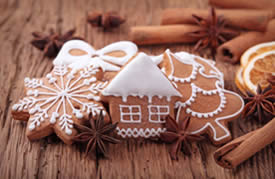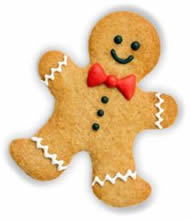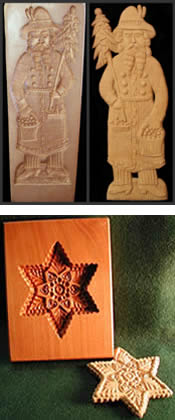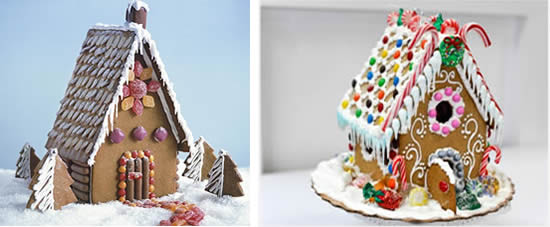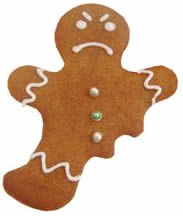| BlueSky Business Aviation News | ||||||||||||||||||||||||||||||||||
| . | ||||||||||||||||||||||||||||||||||
Ohhhhh, it's wonderful! There is no other confection that symbolizes the holidays quite like gingerbread in its many forms; from edible houses to candy-studded gingerbread men, to spiced loaves of cake-like bread. This is a fragrance of the holidays and winter months for enticing passengers and flight crew to attempt something special. The smell is calming, brings memories of family and past winters to mind. Your catering source can provide you with freshly made dough to bake on board so the tantalizing aromas lull everyone into the holiday mood.
So last night I decided I would stray from my normal cutout gingerbread shapes and bake a soft- center drop cookie pressed into coarse sanding sugar for a change. I may still have to make the merry men so the kids can bite their heads off, but it would be something new. Actually I bought a new cookie cookbook and decided I would start on page one and make every cookie in the book, 50 in all. I managed to mix the first 14 recipes yesterday including an alteration in the family recipe for gingerbread. I baked one pan of each cookie and bagged up the rest of the doughs for later baking so I could see if I liked the finished product, or wanted to make any personal changes to the flavor or finishing particulars. I did find the espresso shortbread a bit flat in flavor, so I decided to glaze it with an espresso glaze and drizzle fine lines of chocolate across the top to make the flavor pop a bit . . . perfect.
Could our addition of gingerbread men be because of my love of the story my parents read to me over and over about the gingerbread man? You know the one I mean, it ends with " Run, run as fast as you can; you canít catch me, Iím the Gingerbread Man." I liked the fairy tale story . . . and I always wanted to warn the gingerbread man that the fox would outsmart him and eat him in the end! Gingerbread's history With the Assistance of Google I learned a great deal about gingerbreadís history to share with you. I found it fascinating and hope you enjoy it as well. A side note: In Medieval England, the term gingerbread simply meant Ďpreserved gingerí and wasnít applied to the desserts we are familiar with until the 15th century. The term is now broadly used to describe any type of sweet treat that combines ginger with honey, treacle or molasses.
Gingerbread tied with ribbon was popular at Medieval fairs and, when exchanged, became a token of love. It is written that ladies often gave their favorite knights a piece of gingerbread for good luck in a tournament, or superstitiously ate a 'gingerbread husband' to improve their chances of landing the real thing. I wonder if that would work today. If so, I'm going into the gingerbread business! Gingerbread was international even in the very early times it was made. Did you know that there were specialty guilds that were sanctioned by the ruling authorities to be the only bakers of gingerbread- except at Christmas? When Gingerbread resembles a thin, crisp cookie, it has many names. It is called Snaps. For the Polish itís Piernicki; for the Czechs, Pernik; for the Russians, Pryaniki and for the Croatians Licitars. For those in Scandinavian areas it's Pepparkakor and for the Dutch they are called Speculaas which are cut into hearts or other whimsical shapes. Remember my article recently where I asked whatís in a name? In some places, it was a soft, delicately spiced cake; in others, a crisp, flat cookie, and in others, warm, thick, steamy-dark squares of "bread," sometimes served with a pitcher of lemon sauce or whipped cream. It was sometimes light, sometimes dark, sometimes sweet, sometimes spicy, but it was almost always cut into shapes, and colorfully decorated or stamped with a mold and then dusted with white sugar to make the impression visible. This is yet another example on the importance of a name and its preparation method when you place a catering order. The German preparation is a softer, puffier version known as Lebkuchen. When gingerbread is prepared as a dark, spicy cake the Polish call it Piernik, and the American version of gingerbread cake is frequently served with a lemon glaze or hard sauce. And then there are gingerbread houses . . .
Here the credit must be given to the Germans. They introduced gingerbread houses during the 16th century. The elaborate cookie-walled houses decorated with icing and candies became associated with Christmas tradition. It is curious as to whether the gingerbread house was the inspiration for the Hansel and Gretel story or if the story was inspired by the stories of a house made of confections that was totally edible deep in the woods. Of all the countries in Europe, Germany is the one with the longest and strongest tradition of flat, shaped gingerbreads. Nuremberg became known as the 'gingerbread capital' of the world. Local sculptors, painters, woodcarvers and goldsmiths all contributed to the most beautiful gingerbread cakes in Europe. Gifted craftsmen carved intricate wooden molds, artists assisted with decoration in frosting or gold paint. Incredibly fancy hearts, angels, wreaths and other festive shapes were sold at fairs, carnivals and markets. The quality of the Nuremberg guild's lebkuchen was so high that it was even used as currency for paying city taxes. It was also considered a gift worthy of heads of state and royalty.
Since gingerbread cookies are shaped in the likeness of everything from 'gingerbread men' to assorted animals, I think correct and proper eating can be tricky. Is it barbaric to bite off the head first? Or is it worse to start by amputating an extremity? If you bite on the icing and decorations first, do you hear Shrek, the movie character, say in your head . . . "No,No, Not my gumdrop buttons! ď
Let me introduce myself . . . My name is Paula Kraft and I am founder and President of Tastefully Yours Catering, an aviation specific caterer, located in Atlanta, Georgia for over 35 years.
Currently I am an active member of the NBAA Flight Attendant Committee Advisory Board and the NBAA International Flight Attendant Committee, Women in Corporate Aviation, Women in Aviation International, National Association of Catering Executives, International Flight Catering Association, the International Food Service Association and the International Catererís Association. I have coordinated training programs and clinics for NBAA, EBAA and BA-Meetup conference attendees for over 10 years, created mentoring programs for caterers and flight attendants to broaden their aviation culinary skills, and to assist them in adapting to the unique challenges and constraints found in catering for general aviation. I recognize the need for training and have worked closely with flight departments, flight crews, schedulers and customer service reps at the FBOs to ensure that catering specific training provides information and skills necessary to reduce risk while assisting them in their job duties that include safe food handling, catering security, accurate transmission of food orders, and safe food production, packaging and delivery. I fell into aviation catering quite by accident. I was the in-house caterer and bakery supplier for Macyís department stores in Atlanta when catering was ordered for a Macyís customer which was soon to change my life. After the client enjoyed the catering provided, I was summoned to the clientís corporate office to provide several of the items delivered through Macyís to the executive dining room. Within a week, I was providing food for the flight department and my first order was for the President of a foreign country (as I was too be told soon after). So, here I am, some 35 years later, still loving every minute of every day in aviation catering.
|
||||||||||||||||||||||||||||||||||

